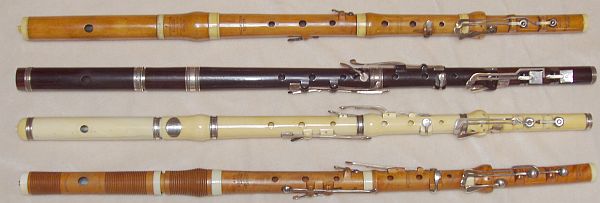
In 1820, better English flutes had C-foots, metal lined tuning heads, and screw-corks. Eight keys was common, and remained so throughout the century, so that the term "eight-key flute" is not inappropriate when speaking of the 19th century English simple system flute in general. (But it is an English term and should be avoided when speaking of continental flutes.) Below are, from top to bottom, flutes by W. H. Potter (six keys, c.1820), T. Monzani (nine keys, 1819), W & J Wainwright (eight keys, c.1828), and Clementi & Co. (eight keys, c.1820).

Many one and four-key London-made boxwood flutes from the decades on either side of 1820 survive and are found in many collections. They look old and are popular with collectors for that reason. Some play great, and they can give much pleasure. But these were not professional instruments, and are not up to playing the more serious English music from that time, in part because the low C appears regularly in the music.
The Wainwright flute is ivory; the Monzani is cocuswood. Such flutes were more common in London made than on the continent in the early 19th century, probably because England's colonies supplied these exotic materials.
The headjoint of the Monzani flute is only partially metal lined, like those of French flutes with tuning heads. Monzani's flutes are interesting and somewhat different than most English flutes; we will have more to say about them elsewhere.
It is hard to see in the photo, but the holes on the Potter are somewhat larger than on the others. In spite of this, many of the forked fingerings are still useable (but not as well in tune as on small-holed flutes, of the types from France and Germany at this time). Experiments with larger holes had been going on for some time, and large-holed flutes would soon become the fashion, or the rage, in London. Flutes with larger holes, and in particular this Potter, could be played with more volume and a reedier tone. The forked fingerings of the one-key flute rely on relatively small holes to be effective, but their loss was not missed if the reedier tone was desired.
The one-key fingering 12-4--k for f''' will fail to work well on many 19C English flutes. It is too sharp, if it speaks at all, and one must use more difficult fingerings involving one or more of the F, G#, and Bb keys. The flute by Monzani above is an exception, though the f''' is still on the sharp side.
We have already mentioned the English virtuoso Charles Nicholson (1795–1837) and his ideas of tone. It is impossible to discuss English flutes without mentioning his influence, but he was by no means the only English flutist to prefer a large and reedy sound. He produced his effects on flutes with large holes, like the eight-key flute by Clementi, c.1830, shown below.

This instrument is in the Fiske Museum of Musical Instruments, Claremont, CA. Thanks to Al Rice for allowing me to make these photographs and post them.
The flute is stamped "Nicholson's Improved". Note that the holes are not of equal size.
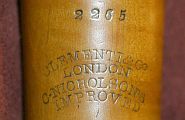
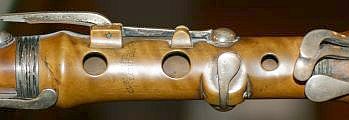
The Clementi flute at the bottom of the first photo on this page is also stamped "Nicholson's Improved". But it has small holes.

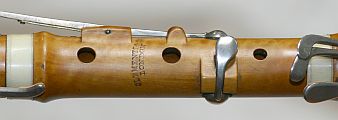
In spite of the small holes, it has some features that Nicholson recommended. In particular, the embouchure is on the large side and the head is narrow in the surrounding region (which means the height of the embouchure walls is less). Below we contrast it with the head of the Potter flute.
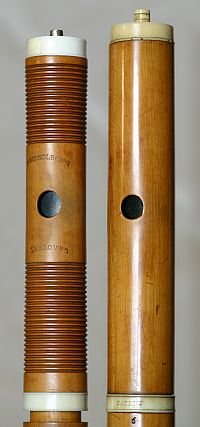
The effect of this voicing, and perhaps differences in the bore, makes this flute by Clementi extremely bright. And it has easy high notes.
The headjoints of the Clementi flutes are "disfigured by ornamental turnings", to use Rockstro's rather mean-spirited terminology. Ornamental turnings can be seen in the illustrations in Nicholson's School for the Flute of 1836.

Large-hole flutes were soon used by all major players in London. Shown below, from top to bottom, are flutes by T. Prowse (c.1860), W. Bark (c.1840), and H. Wylde (c.1850).

The Bark, and to a lesser extent the Prowse, has a flattened area surrounding holes 4 and 5. Nicholson recommended this; it eases the "glide" from F to G or F# to G.

Nicholson also approved of an ivory-bushed embouchure, as on the Bark and the Prowse, as well as an excavation for the base of LH1 on the audience side of the flute, as on the Prowse (which is also stamped "Nicholson's Improved").

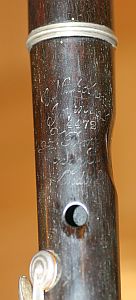
The Bark and the Wylde have "salt spoon" keys mounted in wooden blocks. This would become less common after mid-century; and the Prowse has keys for more-or-less normal pads mounted on posts. But all flutes have pewter plug keys on the open-standing low C and C#. Details of the Bark are shown below.

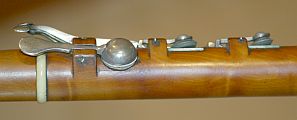
The large-holed English flutes can be very difficult to handle. Intonation is weird. The low d' is often very flat, while the a' and b' are sharp. The e''' and e'''b can be flat. Often bore shrinkage exacerbates the problems, but these symptoms seem to be part of the design. The correct method of blowing can help. They seem to require a tight embouchure with the lips above but close to the outer edge, and like to be played "on the edge", where notes, especially the lower octave notes, are about to overblow into higher harmonics. Then the tuning seems better, and the tone is wonderfully rich. No other type of flute can sound like this. But to keep this up for long takes a lot of strength. Nicholson could do it, but some of the rest of us have trouble. I do not feel that I play my best on this style of flute, but after demonstrations that include numerous flutes, many listeners will recall and comment favorably on the memorable and distictive sound of the Nicholson flute.
While professionals used large holed flutes, small and medium holes remained as options. Clinton's 8-key metal "flute for India" (1860) was still available with large, medium, or small holes.
A highly respected flute manufacturer in London was the firm of Rudall and Rose, founded in 1821. They later became Rudall, Rose & Carte, and then Rudall, Carte & Co., and were still producing flutes in 1950. They offered many options on simple system flutes. While they continued to provide 8-key flutes, they became promoters of the Boehm flute in the 1840's. The instrument below (c.1835) has a Bb foot with all four open-standing keys assigned to RH4. This flute has "medium" holes.


Another feature is the Rudall & Rose Patent Head, which was used on many of their best instruments after 1832. This head did not have a standard screw-cork with an indicator, but twisting the endcap caused both the tuning slide and the cork to move. The cork would move in (towards the embouchure) 1/4 mm for every mm the barrel joint extended from, or moved out of, the head proper. One must accept the judgement of R & R as to where the cork should be placed.
The more sophisticated English flutists became fond of pieces in F major and flat keys. Presumably, English flutes sound well in those keys. See W. N. James' comments (1826) on the best modes for the flute.
The high notes can be surprisingly easy on the large-holed flutes.
19th century English flutes are used by players of Irish music in the traditional style. More about this elsewhere.
The English preference for a powerful and reedy sound led them to appreciate the Boehm flute, at first the conical model and then the cylindrical, with its larger tone holes. Many did not like Boehm's fingering, however. Especially the change from RH1 producing F# on the simple system flute, to F on the Boehm. The result was a number of attempts to put the old fingering on more rationally designed flutes, often with cylindrical bores and large holes. More about this elsewhere. The simple system instruments were not popular in the second half of the 19th century, in England, among serious flutists.